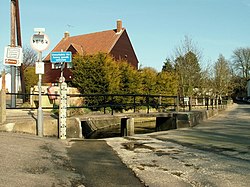Steeple Bumpstead
| Steeple Bumpstead | |
| Essex | |
|---|---|
 The footbridge on the corner of Church Street | |
| Location | |
| Location: | 52°2’40"N, 0°26’54"E |
| Data | |
| Population: | 1,627 (2011[1]) |
| Post town: | Haverhill |
| Postcode: | CB9 |
| Dialling code: | 01440 |
| Local Government | |
| Council: | Braintree |
| Parliamentary constituency: |
Braintree |
Steeple Bumpstead is a village and parish in Essex, three miles south of Haverhill.
The parish church does not have a steeple, however the Congregational Church has a small Victorian one. It is believed that the steeple referred to was located on the A1307 close to what is now the Wixoe Pumping Station.
History
Bumstead or Bumsted is Anglo-Saxon for "place of reeds". The Moot Hall is recorded in the Domesday Book. In feudal times it was called Bumstede ad Trim, from "ac-Turrum" or "with the tower" The Knights Templar positioned themselves on the river. The town is notable for its Lollard connections.[2]
There has been a long history on non-conformist belief in the village which continues to this day in the [ongregational Church. A Bumpstead man was burnt to death in the parish for his beliefs. Along the Blois Road, leading from Bumpstead to Birdbrook, is a field that has been called the ‘Bloody Pightle’, and that is where he is believed to have been martyred. In 1527 John Tibauld and eight other village residents were seized and taken before the Bishop of London, charged with meeting together in Bower Hall to pray and read a copy of the New Testament. Although the non-conformists in the village were encouraged by the powerful Bendyshe family that lived at Bower Hall, even their influence could not save Tibauld. He was burned at the stake.
Having fallen into ruin after use as a ‘concentration camp’ in the First World War, Bower Hall was finally demolished in 1926 and the materials sold off. The great staircase found its way to the United States.
A Moot Hall, known as ‘the Old Schole’, symbolises Steeple Bumpstead. Built in 1592 by the inhabitants on land rented from the Crown, in the 1830s when it was ‘a school for farmers' sons’ the villagers forcibly took possession of it, disputing the claim of George Gent of Moyns to have the right to appoint the headmaster. Eventually an ecclesiastical court upheld the villagers' claim.
Steeple Bumpstead was one of the first villages in the country to have its own village policeman when county policing came into being in Essex. In 1840, William Rattigan was one of the very first Essex Police Officers to be assigned a village beat. There was a police officer stationed in the village for 160 years from 1840 to 2000 when the last 'bobby', Ray Howard, retired.
Modern times
There are many facilities in Steeple Bumpstead including a local village store, a Post Office, a petrol station, an antiques shop, and a library in the aforementioned Moot Hall. Steeple Bumpstead has its own medical practice. There are two pubs, The Fox and Hounds and The Red Lion.
There are two churches, the Church of England parish church of St. Mary's and the Congregational Church, each offering various activities for all ages. St Mary's is a Grade-I listed building dating from the 11th century.[3]
Steeple Bumpstead has a primary school, Steeple Bumpstead Primary School.
Steeple Bumpstead has a Scout Group: 1st Steeple Bumpstead Scouts which consists of a Beaver Colony, A Cub Pack and a Scout Troop. The group in total has circa 100 members. There is also an active Brownies group, and a Girl Guides group.
In popular culture
Steeple Bumpstead is mentioned in the first pages of the 2007 novel "The Reavers" by George MacDonald Fraser.
The village is referred to in Episode 5 of the first series of 'The Fall and Rise of Reginald Perrin' broadcast on BBC1 (1976). Perrin tries to insult a colleague by saying that they have a degree in 'Applied Manure from The University of Steeple Bumpstead'.
Notable residents
Nurse Edith Cavell had ties with Steeple Bumpstead long before she became a nurse. During 1886, Edith was appointed governess to the four children of the Reverend Charles Powell, vicar of Steeple Bumpstead. The former vicarage, where a stone plaque commemorates her stay, is a private residence on the corner of Chapel Street and Finchingfield Road. There is a plaque about Edith Cavell in the 11th-century village church and a road named after her.
Colonel J. C. Humphrey, son of the village wheelwright, allegedly invented corrugated iron. He built and lived in the Iron House, North Street, which was demolished in the 1960s. At one time Humphreys Ltd of London claimed to be the ‘largest works in the world’ and held a Royal Warrant as ‘supplier to His Majesty King Edward VII’.
Lord and Lady Taylor moved to the village in 2013.
References
| ("Wikimedia Commons" has material about Steeple Bumpstead) |
- ↑ "Civil Parish population 2011". Neighbourhood Statistics. Office for National Statistics. http://www.neighbourhood.statistics.gov.uk/dissemination/LeadKeyFigures.do?a=7&b=11129048&c=Steeple+Bumpstead&d=16&e=62&g=6422863&i=1001x1003x1032x1004&m=0&r=1&s=1473240455797&enc=1. Retrieved 7 September 2016.
- ↑ Fissell, Mary Elizabeth (2004). Vernacular Bodies: The Politics of Reproduction in Early Modern England. Oxford University Press. p. 36. ISBN 0199269882. https://books.google.com/books?id=euwTDAAAQBAJ&pg=PA36&lpg=PA36&dq=%22Paternoster+Press%22+++%22known+for%22&source=bl&ots=xNbeCACTah&sig=bE7p5otXM4eeOh4IPQoD7ATGmqQ&hl=en&sa=X&ved=0ahUKEwjS1N7fnYnUAhUCC8AKHWOiDesQ6AEISDAG#v=onepage&q=%22Paternoster%20Press%22%20%20%20%22known%20for%22&f=false. Retrieved 24 May 2017.
- ↑ "Name: PARISH CHURCH OF ST MARY THE VIRGIN List entry Number: 1166315". English Heritage. http://list.english-heritage.org.uk/resultsingle.aspx?uid=1166315. Retrieved 20 April 2014.